engine Lexus GX470 2007 Instrument cluster / LEXUS 2007 GX470 (OM60C64U) Manual PDF
[x] Cancel search | Manufacturer: LEXUS, Model Year: 2007, Model line: GX470, Model: Lexus GX470 2007Pages: 436, PDF Size: 11.52 MB
Page 365 of 436

5
When trouble arises
345
5-1. Essential information
Event data recorder
In a crash or a near car crash eventThe EDR may record some or all of the following information.
● Engine speed
● Whether the brake pedal was applied or not
● Vehicle speed
● To what extent the accelerator pedal was depressed
● Position of the transmission shift lever
● Whether the driver and front passenger wore seat belts or not
● Driver's seat position
● Front passenger's occu pant classification
● SRS airbag deployment data
● SRS airbag system diagnostic data
Your Lexus’ Electronic Control U nit (ECU) may contain another EDR.
There are a variety of driving situation s which include activating the vehi-
cle stability control (VSC) under whic h the VSC EDR will record certain
information. The VSC EDR may record so me or all of the following infor-
mation:
● Behavior of the vehicle
● Steering wheel angle
Your vehicle has computers that monitor and control certain aspects of
your vehicle. These computers assist in driving and maintaining optimal
vehicle performance.
Besides storing data useful for troubles hooting, there is a system to record
data in a crash or a near car crash event. This is called an Event Data
Recorder (EDR).
Page 368 of 436
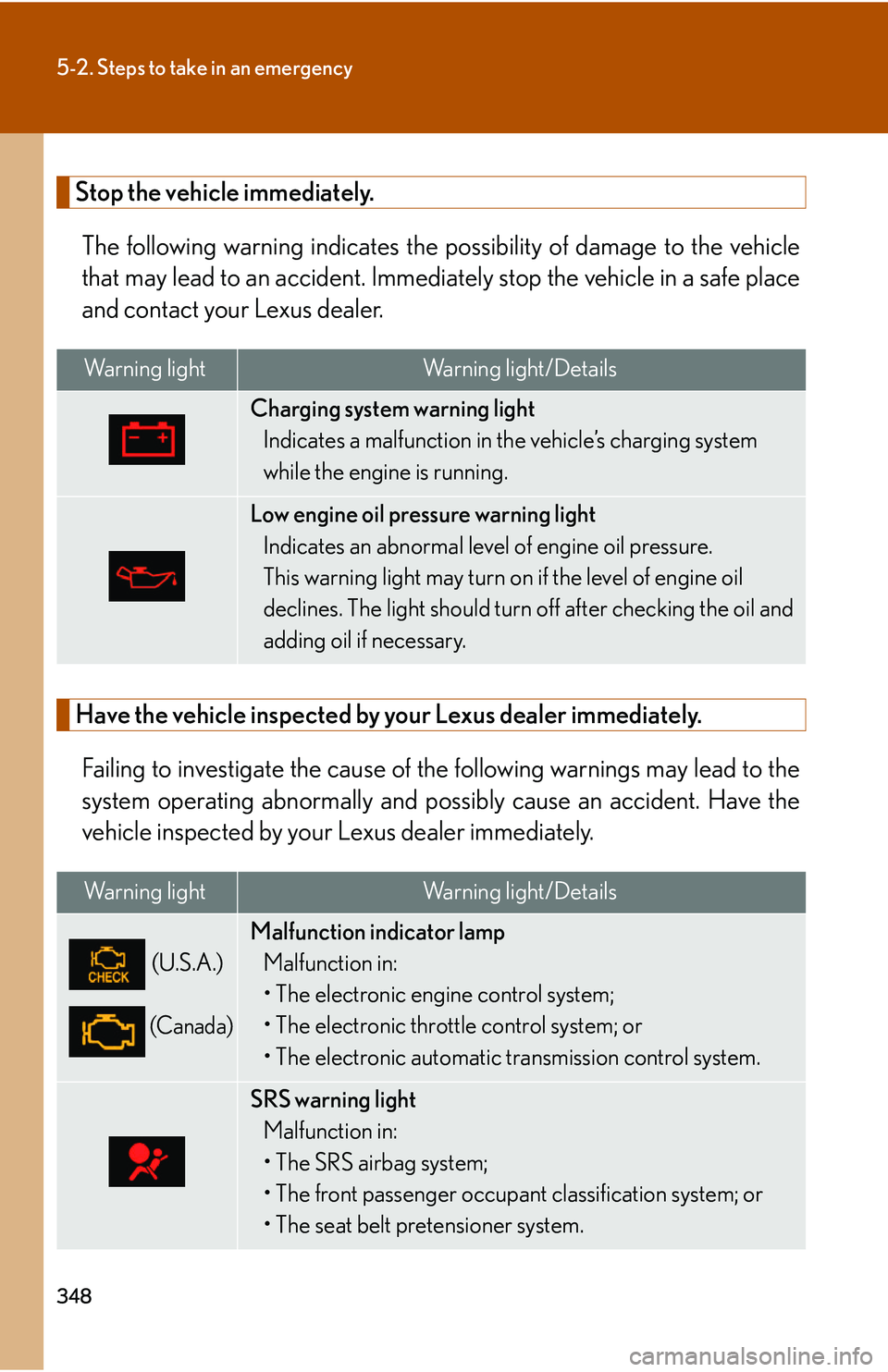
348
5-2. Steps to take in an emergency
Stop the vehicle immediately.The following warning indicates the po ssibility of damage to the vehicle
that may lead to an ac cident. Immediately stop the vehicle in a safe place
and contact your Lexus dealer.
Have the vehicle inspected by y our Lexus dealer immediately.
Failing to investigate the cause of the following warnings may lead to the
system operating abnormally and possibly cause an accident. Have the
vehicle inspected by your Lexus dealer immediately.
Warning lightWarning light/Details
Charging system warning light
Indicates a malfunction in the vehicle’s charging system
while the engine is running.
Low engine oil pressure warning light
Indicates an abnormal level of engine oil pressure.
This warning light may turn on if the level of engine oil
declines. The light should turn off after checking the oil and
adding oil if necessary.
Warning lightWarning light/Details
(U.S.A.)
(Canada)
Malfunction indicator lampMalfunction in:
• The electronic engine control system;
• The electronic throttle control system; or
• The electronic automatic transmission control system.
SRS warning lightMalfunction in:
• The SRS airbag system;
• The front passenger occupant classification system; or
• The seat belt pretensioner system.
Page 370 of 436
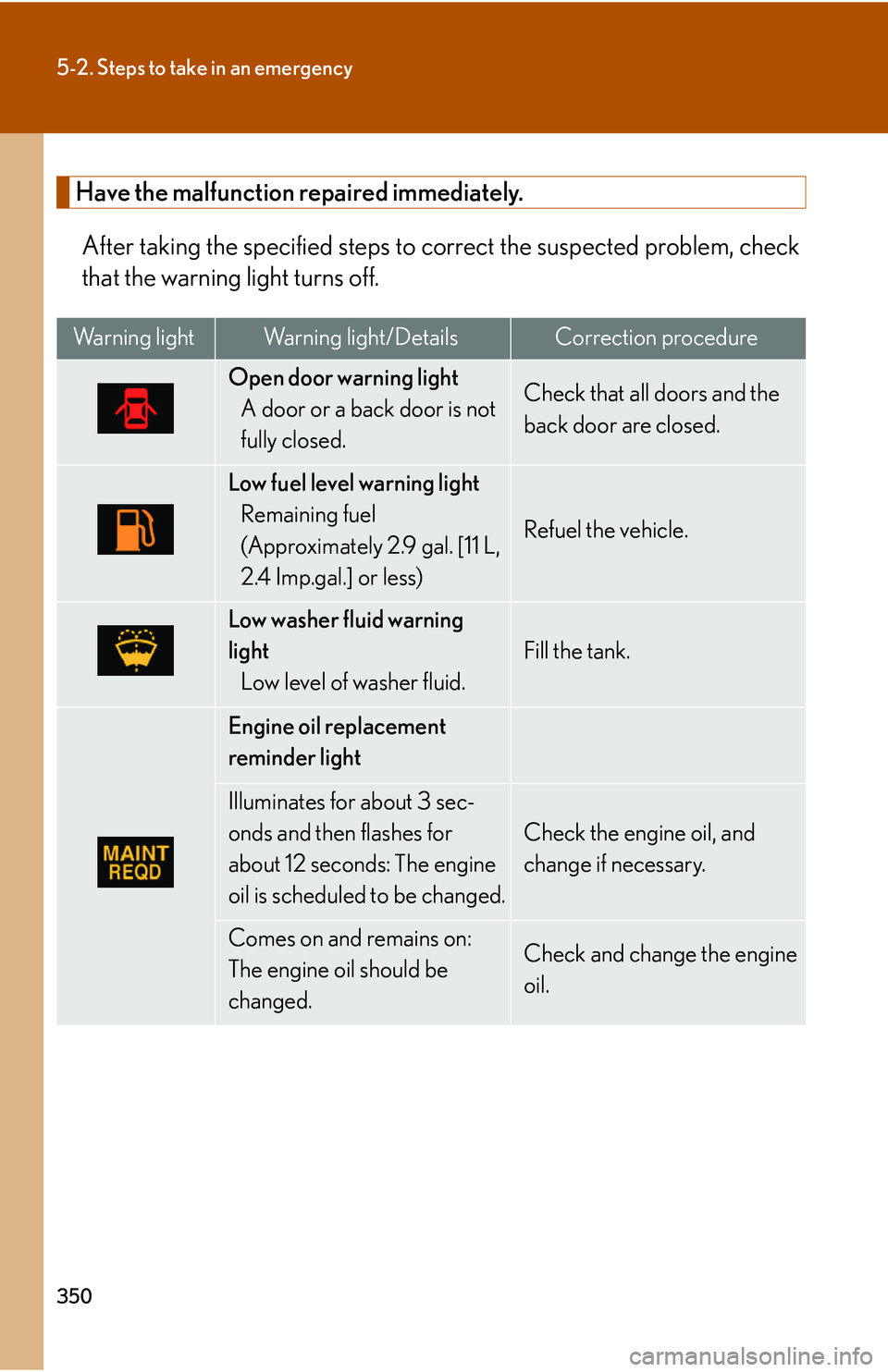
350
5-2. Steps to take in an emergency
Have the malfunction repaired immediately.After taking the specified steps to co rrect the suspected problem, check
that the warning light turns off.
Warning lightWarning light/DetailsCorrection procedure
Open door warning light
A door or a back door is not
fully closed.Check that all doors and the
back door are closed.
Low fuel level warning lightRemaining fuel
(Approximately 2.9 gal. [11 L,
2.4 Imp.gal.] or less)
Refuel the vehicle.
Low washer fluid warning
lightLow level of washer fluid.
Fill the tank.
Engine oil replacement
reminder light
Illuminates for about 3 sec-
onds and then flashes for
about 12 seconds: The engine
oil is scheduled to be changed.
Check the engine oil, and
change if necessary.
Comes on and remains on:
The engine oil should be
changed.Check and change the engine
oil.
Page 374 of 436
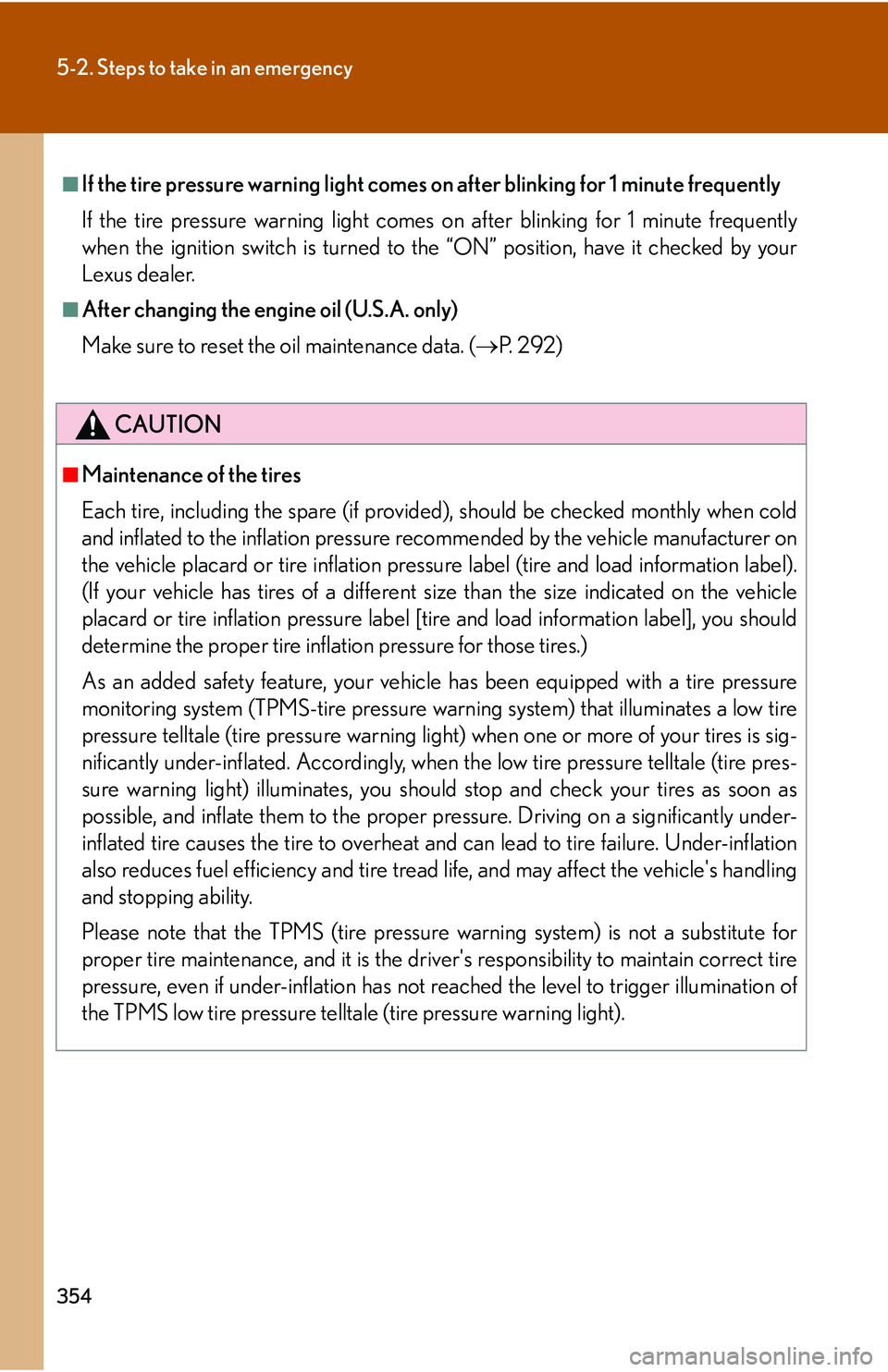
354
5-2. Steps to take in an emergency
■If the tire pressure warning light comes on after blinking for 1 minute frequently
If the tire pressure warning light comes on after blinking for 1 minute frequently
when the ignition switch is turned to th e “ON” position, have it checked by your
Lexus dealer.
■After changing the engine oil (U.S.A. only)
Make sure to reset the oil maintenance data. ( P. 2 9 2 )
CAUTION
■Maintenance of the tires
Each tire, including the spare (if provided ), should be checked monthly when cold
and inflated to the inflation pressure re commended by the vehicle manufacturer on
the vehicle placard or tire inflation pressu re label (tire and load information label).
(If your vehicle has tires of a different size than the size indicated on the vehicle
placard or tire inflation pressure label [tire and load information label], you should
determine the proper tire inflation pressure for those tires.)
As an added safety feature, your vehicl e has been equipped with a tire pressure
monitoring system (TPMS-tire pressure warning system) that illuminates a low tire
pressure telltale (tire pressure warning light) when one or more of your tires is sig-
nificantly under-inflated. Accordingly, when the low tire pressure telltale (tire pres-
sure warning light) illuminates, you should stop and check your tires as soon as
possible, and inflate them to the proper pressure. Driving on a significantly under-
inflated tire causes the tire to overheat and can lead to tire failure. Under-inflation
also reduces fuel efficiency and tire tread life, and may affect the vehicle's handling
and stopping ability.
Please note that the TPMS (tire pressure warning system) is not a substitute for
proper tire maintenance, and it is the driv er's responsibility to maintain correct tire
pressure, even if under-inflation has not reached the level to trigger illumination of
the TPMS low tire pressure telltale (tire pressure warning light).
Page 376 of 436
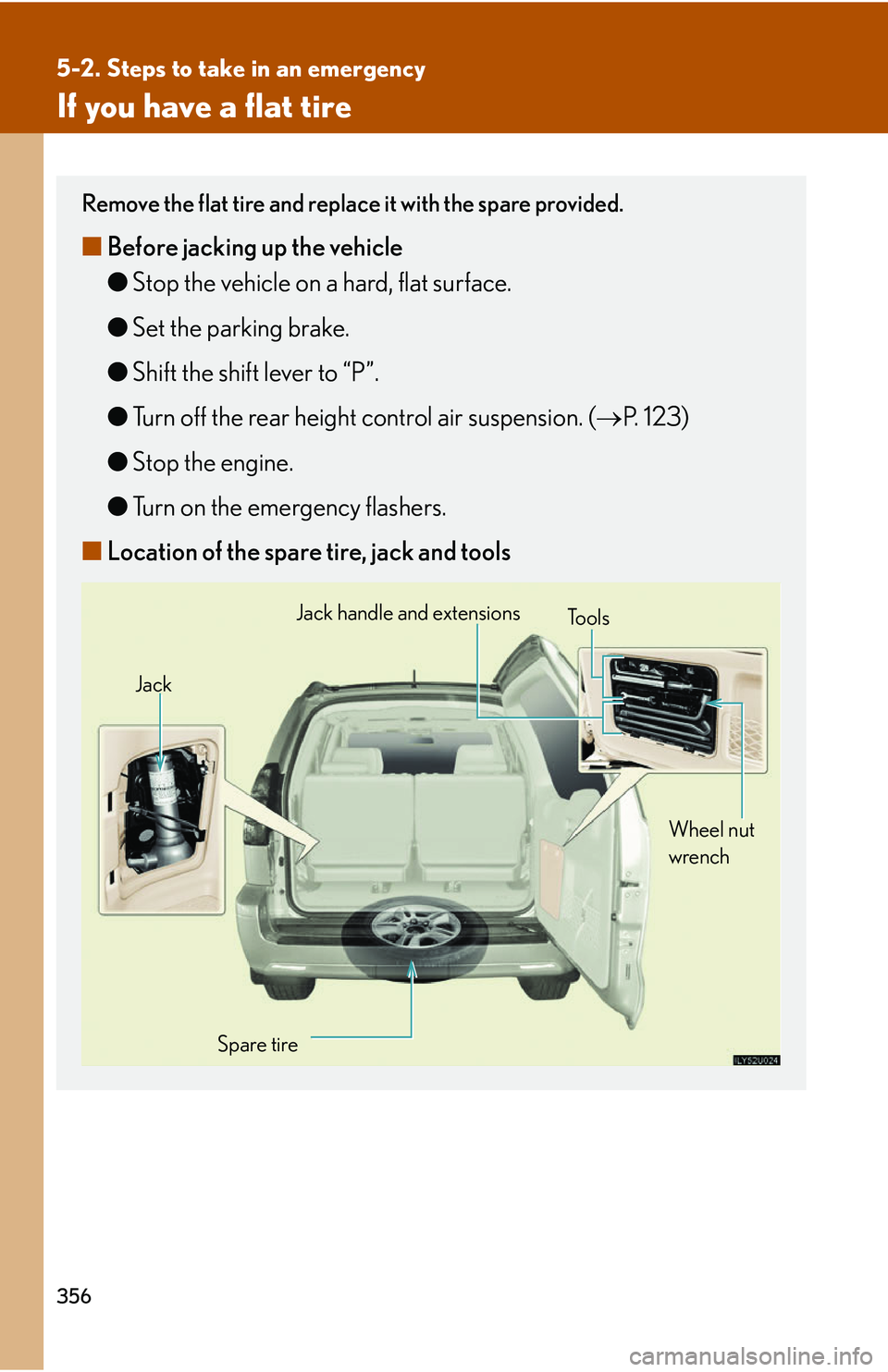
356
5-2. Steps to take in an emergency
If you have a flat tire
Remove the flat tire and replace it with the spare provided.
■Before jacking up the vehicle
●Stop the vehicle on a hard, flat surface.
● Set the parking brake.
● Shift the shift lever to “P”.
● Turn off the rear height control air suspension. ( P. 123)
● Stop the engine.
● Turn on the emergency flashers.
■ Location of the spare tire, jack and tools
Wheel nut
wrench
Spare tire
Jack
Tools
Jack handle and extensions
Page 384 of 436

364
5-2. Steps to take in an emergency
CAUTION
■Using the tire jack
Improper use of the tire jack may lead to death or injuries due to the vehicle sud-
denly falling off the jack.
●Do not use the tire jack for any purpose other than replacing tires or installing and
removing tire chains.
●Only use the tire jack that comes with this vehicle for replacing a flat tire.
Do not use it on other vehicles, and do not use other tire jacks for replacing tires
on this vehicle.
●Always check that the tire jack is securely set to the jack point.
●Be sure to turn off the rear height co ntrol air suspension and stop the engine.
●Do not raise the vehicle while someone is in it.
●When raising the vehicle, do not put an object on or under the jack.
●Do not raise the vehicle to a height greate r than that required to replace the tire.
●Use a jack stand if it is necessary to get under the vehicle.
●Do not put any part of your body under the vehicle supported by a jack.
●Do not start or run the engine while your vehicle is supported by the jack.
Take particular care when lowering the vehicle to ensure that no one working on or
near the vehicle may be injured.
■Using the jack handle
Tighten all the jack handle bolts securely using a Phillips-head screwdriver, to pre-
vent the extension parts from coming apart unexpectedly.
Page 387 of 436

5
When trouble arises
367
5-2. Steps to take in an emergency
If the engine will not start
If the engine will not start even though correct starting procedures are
being followed (
P. 95), consider each of the following points.
■The engine will not start even when the starter motor operates
normally
One of the following may be the cause of the problem.
● There may not be sufficient fuel in the vehicle’s tank.
Add fuel to the vehicle.
● The engine may be flooded.
Try to restart the engine once more following correct starting
procedures. ( P. 9 5 )
● There may be a malfunction in the engine immobilizer system.
( P. 4 9 )
■ The starter motor turns over slowly, interior lights and headlights
are dim, or the horn does not sound or sounds at a low volume
One of the following may be the cause of the problem.
●The battery may be discharged. ( P. 370)
● The battery terminal connections may be loose or corroded.
■ The starter motor does not turn over, interior lights and headlights
do not turn on, or the horn does not sound
One of the following may be the cause of the problem.
●One or both of the battery terminals may be disconnected.
● The battery may be discharged. ( P. 370)
Contact your Lexus dealer if the problem cannot be repaired, or if
repair procedures are unknown.
Page 390 of 436
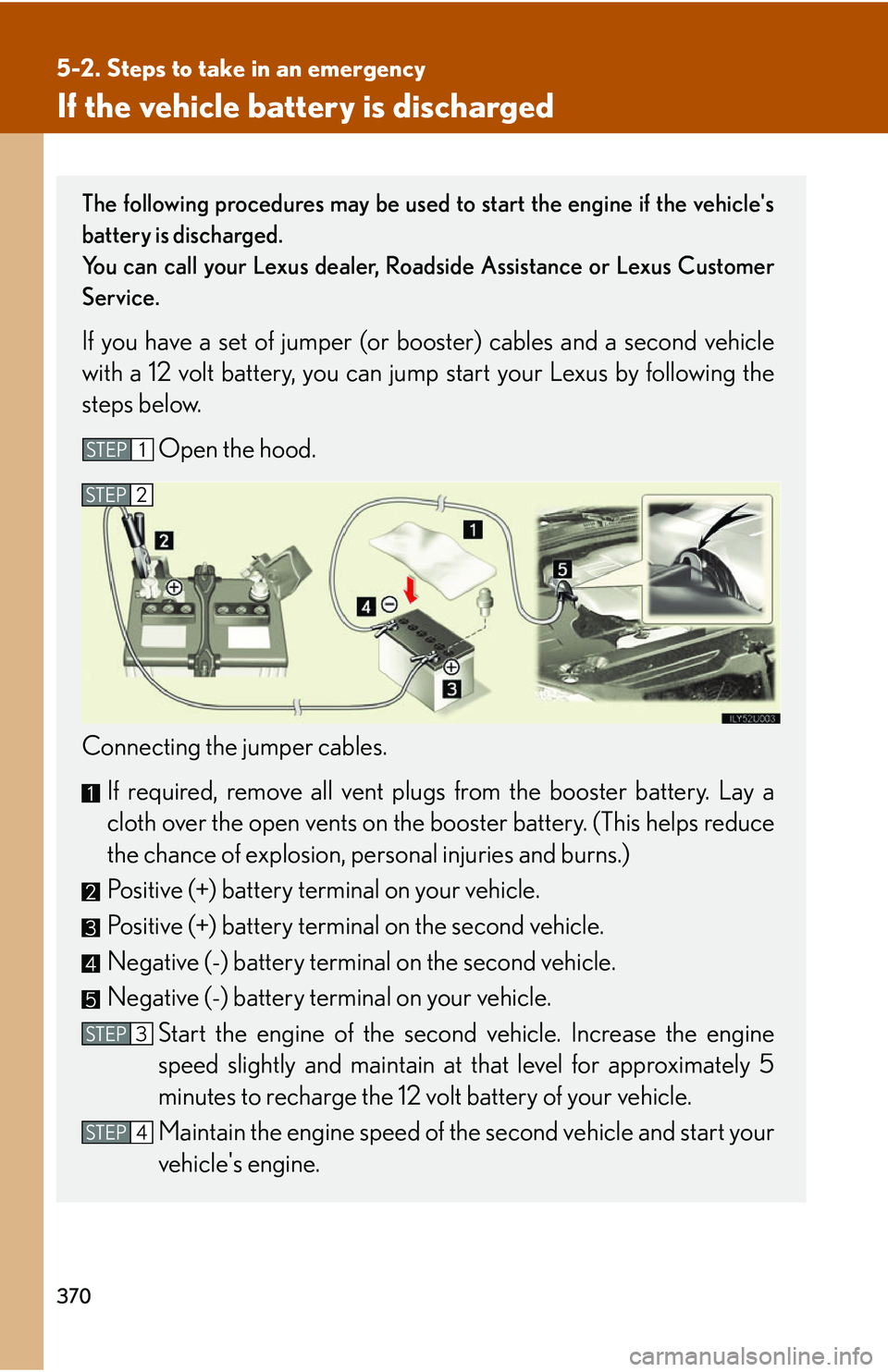
370
5-2. Steps to take in an emergency
If the vehicle battery is discharged
The following procedures may be used to start the engine if the vehicle's
battery is discharged.
You can call your Lexus dealer, Roadside Assistance or Lexus Customer
Service.
If you have a set of jumper (or booster) cables and a second vehicle
with a 12 volt battery, you can jump start your Lexus by following the
steps below.
Open the hood.
Connecting the jumper cables. If required, remove all vent plugs from the booster battery. Lay a
cloth over the open vents on the booster battery. (This helps reduce
the chance of explosion, pe rsonal injuries and burns.)
Positive (+) battery terminal on your vehicle.
Positive (+) battery terminal on the second vehicle.
Negative (-) battery terminal on the second vehicle.
Negative (-) battery terminal on your vehicle. Start the engine of the second vehicle. Increase the engine
speed slightly and maintain at that level for approximately 5
minutes to recharge the 12 volt battery of your vehicle.
Maintain the engine sp eed of the second vehicle and start your
vehicle's engine.
STEP1
STEP2
STEP3
STEP4
Page 391 of 436
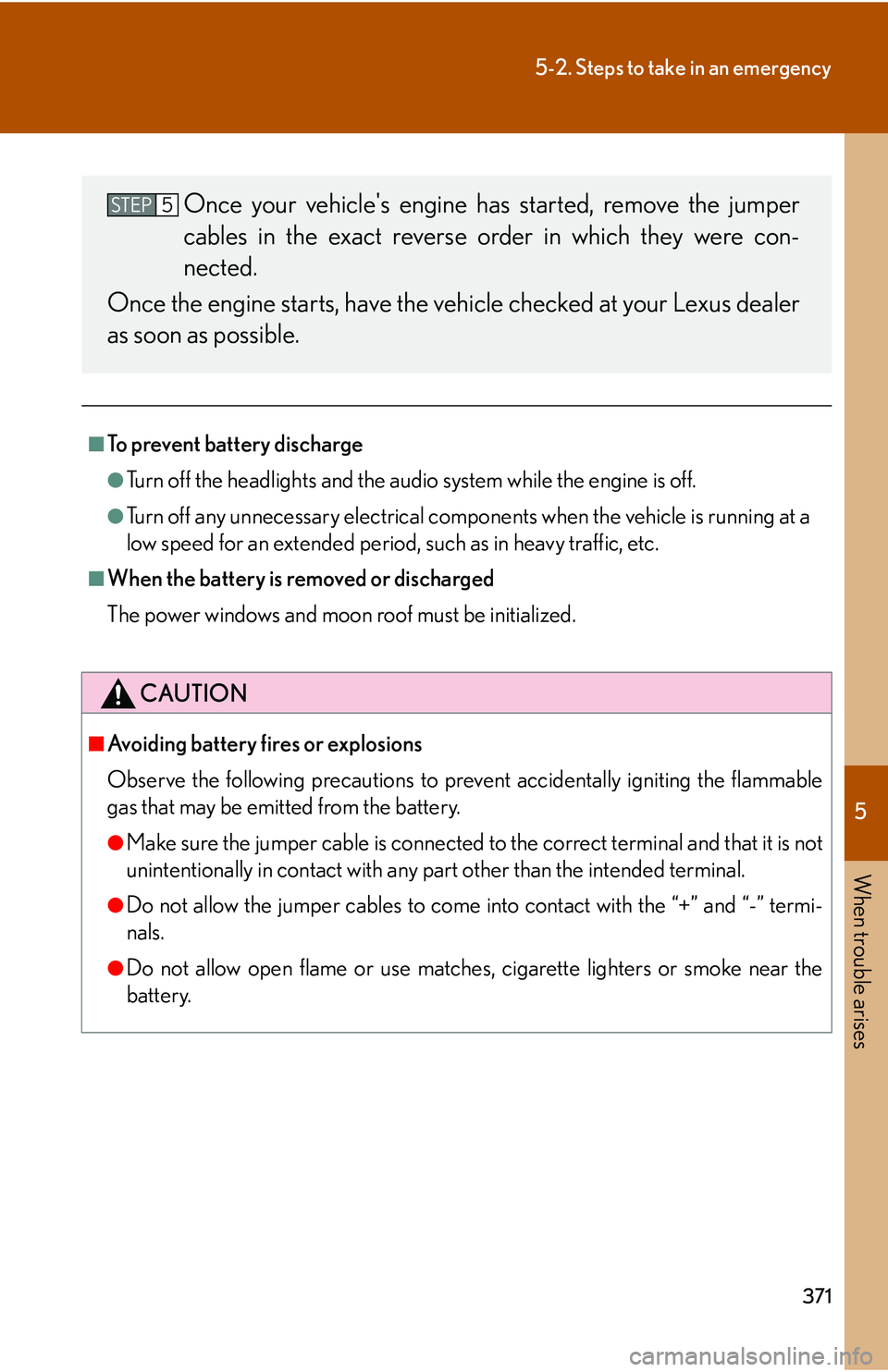
5
When trouble arises
371
5-2. Steps to take in an emergency
■To prevent battery discharge
●Turn off the headlights and the audio system while the engine is off.
●Turn off any unnecessary electrical components when the vehicle is running at a
low speed for an extended period, such as in heavy traffic, etc.
■When the battery is removed or discharged
The power windows and moon roof must be initialized.
CAUTION
■Avoiding battery fires or explosions
Observe the following precautions to prevent accidentally igniting the flammable
gas that may be emitted from the battery.
●Make sure the jumper cable is connected to the correct terminal and that it is not
unintentionally in contact with any pa rt other than the intended terminal.
●Do not allow the jumper cables to come into contact with the “+” and “-” termi-
nals.
●Do not allow open flame or use matches, cigarette lighters or smoke near the
battery.
Once your vehicle's engine has started, remove the jumper
cables in the exact reverse ord er in which they were con-
nected.
Once the engine starts, have the ve hicle checked at your Lexus dealer
as soon as possible.STEP5
Page 393 of 436

5
When trouble arises
373
5-2. Steps to take in an emergency
If your vehicle overheats
If the engine overheats:
Stop the vehicle in a safe place and turn off the automatic air
conditioning system.
Check to see if steam is coming out from under the hood.
If you see steam: Turn off the engine and carefully lift the hood.
If you do not see steam: Leave the engine running and carefully lift the hood.
Check to see if the cooling fan is operating.
If the fan is operating: Wait until the engine coolant temperature gauge begins to
fall and then stop the engine.
If the fan is not operating: Stop the engine immediately and call your local Lexus
dealer.
After the engine has cooled
down sufficiently, check the
coolant level and inspect the
radiator for any leaks.STEP1
STEP2
STEP3
STEP4